Modelsvit Bf-109D-1
The Airplane:
Developed from the V10 and V13 prototypes,the Bf-109D was the last model of the Jumo powered 109s to enter service and it was built in larger numbers than the previous three subtypes combined. The Bf 109D was the standard version of the Bf 109 in service with the Luftwaffe just before the start of World War II. Despite this, the type saw only limited service during the war, as all of the 235 Bf 109Ds still in Luftwaffe service at the beginning of the Poland Campaign were rapidly taken out of service and replaced by the Bf 109E, except in some night fighter units where some examples were used into early 1940.
Variants included the D-0 and D-1 models, both having a Junkers Jumo 210D engine and armed with two wing-mounted and two nose- mounted 7.92 mm MG 17s. A total of 647 Bf 109Ds of all versions were built by Focke-Wulf, Erla, Fieseler, Arado and AGO.
Messerschmitt is listed as having produced only four Bf 109Ds, probably the D-0 preproduction series with the serial production transferred to the licensed manufacturers. Several Bf 109Ds were sold to Hungary. Switzerland bought 10 109D-1s (Serial Numbers from 2301 until 2310) which had been built by the Arado- Flugzeugwerke GmbH factory located in Warnemünde.
Max Ibel:
Max Ibel, one of the founders of the Luftwaffe, joined the German Army as a cadet in July 1915, serving with the 1st Bavarian Pioneer battalion; he was commissioned an officer in August 1916.
When the war ended he remained in the new Reichswehr, serving with the First Engineer Battalion in Munich. In July 1928 he left the Army for pilot training at the Lipetsk fighter-pilot school in the Soviet Union, where Luftwaffe aircrew were secretly trained.
Returning to Germany in May 1932, Ibel was promoted to Hauptmann, and served as an Instructor with the Jagdfliegerschule in Schleissheim. In November 1935 he was promoted to Major.
In May 1936, he became Gruppenkommandeur of I/JG 134 in Dortmund. From December 1936 to February 1937, Ibel led I/JG 232 in Bernburg and in March transferred to I/JG 135.
In November 1938, he was promoted to Oberstleutnant and commanded of JG 233 which was formed from I/JG135 and was later renamed JG 3 “Udet”. The unit took part in the Austrian Anschluss that month.
Promoted to Oberst in 1939, Ibel led JG 27 successfully during the Battle of France and the Battle of Britain until October 1940. He was awarded the Knight's Cross of the Iron Cross on August 22. 1940.
In October 1940, Oberst Ibel became Kommandeur of Jagdfliegerschule 4, where he remained until June 1941, when he was promoted to Generalmajor, and appointed Jagdfliegerführer 3 (Jafü 3). In February 1942 Ibel was liaison officer with the Kriegsmarine during the Channel Dash when the Luftwaffe provided effective air cover over the battle cruisers Scharnhorst and Gneisenau, and heavy cruiser Prinz Eugen passage through the English Channel.
In December 1942, he became Jagdfliegerführer West, and in October 1943 assumed command of 2. Jagd-Division, in northern Germany. During the last two years of the War Ibel was commander of 2. Jagd-Division and at the very end of the War he became Inspector of Jet operations.
After time as a POW with the Western Allies, Ibel was released in 1948. He rejoined the German Air Force in October 1957 as a Brigadier General.
The Kit:
Modelsvit is one of several companies, the others being Dora Wings and AMG that are under the umbrella of Mikro-Mir, which was previously known as Amodel. Among the first products of the new companies was a series of early 109s, with Dora Wings and AMG releasing the Bf-109A and Bf-109B respectively, while Modelsvit has now released the Bf-109C and Bf-109D. Outside of detail differences like span of the leading edge slats and other items that differentiate the sub-types, these are all the same kit.
The Modelsvit Bf-109D includes markings for six different Bf-109Ds, including the airplane flown by Werner Molders, three different Luftwaffe units, a Swiss and a Hungarian unit.
I used the Aeromaster “Birth of the Luftwaffe Part 2" sheet to do Max Ibel's Bf-109D when he commanded 1/JG 233 during the Anschluss.
Construction:
At the time of the release of the Bf-109A and B, a well-known alleged experte modeler over at The Other Place declared the kits “very difficult” and published photos of his model with putty over every joint. That was not my experience with either the Dora Wings or AMG kits, or with this release from Modelsvit.
One needs to be aware that these are “limited run” kits, though of very high-end quality, but still requiring a modelers to clean up the parts - paying particular attention to getting rid of sprue nubs. If one also does careful test-fitting and modifies the parts where necessary until satisfied with the fit before gluing, the result will be a model that only requires putty along the centerline of the upper cowling and the lower radiator. Ham-fisted model construction of these kits will result in a putty monster (such a construction style usually results in this).
Again, committing the revolutionary act of following the instructions will, when combined with test-fitting and care in assembly before applying glue, lead to a very nice-looking model.
Painting and Markings:
I used Tamiya XF-23 (RLM65) for the lower surfaces and XF-27 Black Green (RLM70) and XF-61 “Dark Green” (RLM71) to do the prewar Luftaffe scheme.
The Aeromaster decals went down without trouble.
Final Finish and Assembly:
I gave the model an overall coat of clear flat, then applied exhaust and gunfire stains with Tamiya “Smoke.”
The landing gear and prop were attached and the canopy mounted in the open position.
Overall:
Until Eduard decides to do early 109s, these kits from Dora Wings, AMG and Modelsvit are the best early 109 kits available in 1/48. They create no problems for a modeler who takes his or her time in test-fitting, and look very good sitting next to any other company's 109s on the shelf. Not for beginners, but any modeler with average experience should have no trouble. Highly recommended.
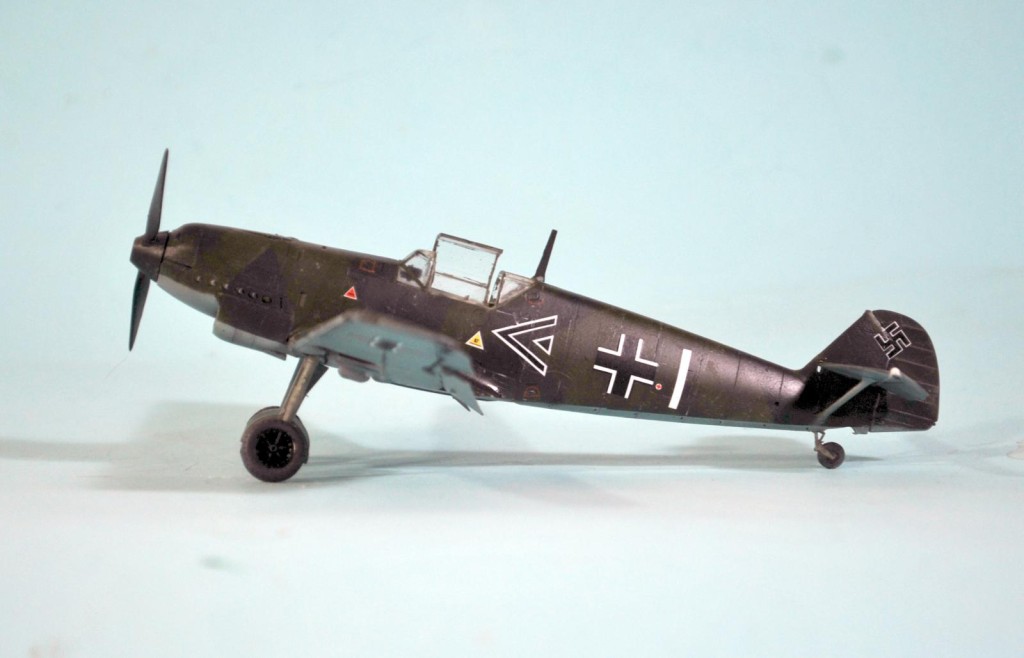
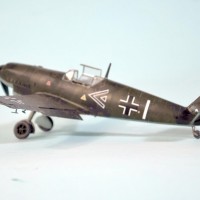

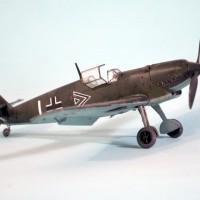
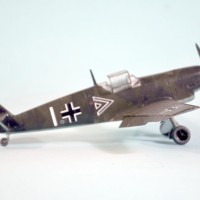
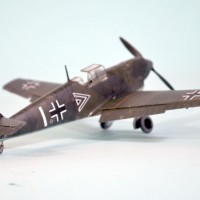
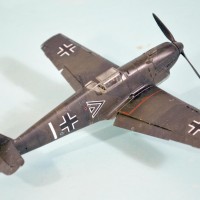

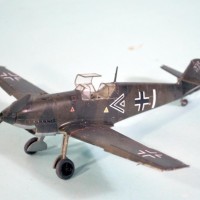
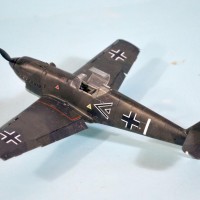
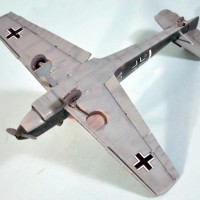
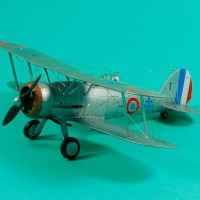

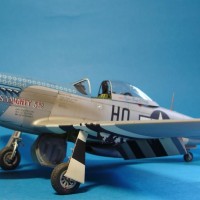

Sharp work, Tom. Always nice to see an early 109. Your paintwork really looks spot on color wise.
Nice job, Tom. Like the not-everyday 109 scheme.
Excellent model and article, Tom!
Superb build of this early 109, Tom @tcinla
Great article about Max Idel as well.
Nice job, great looking early 109, also great read on Max Idel.
Very nice Dora 109 Tom. Reading your opinion and build experience I get the feeling this kit builds more or less as good as Wingsy Emils? Perhaps with less PE
@holzhamer - not quite Wingsy, but close. Les p-e for sure
Another great write up, Tom. Great info on the Dora and on Max Idel.
AND an excellent looking Dora.
Very nice Tom. I love the early 109s.
Nice painting! I like early Bf109, ecpecially E version.
Very nice!